An Economic Approach to Assess the Annual Stock in Beekeeping Farms: The Honey Bee Colony Inventory Tool
Abstract
1. Introduction
2. Materials and Methods
3. Results
4. Discussion
Author Contributions
Funding
Acknowledgments
Conflicts of Interest
References
- Klein, A.M.; Vaissière, B.E.; Cane, J.H.; Steffan-Dewenter, I.; Cunningham, S.A.; Kremen, C.; Tscharntke, T. Importance of pollinators in changing landscapes for world crops. Proc. R. Soc. B Biol. Sci. 2007, 274, 303–313. [Google Scholar] [CrossRef]
- Potts, S.G.; Biesmeijer, J.C.; Kremen, C.; Neumann, P.; Schweiger, O.; Kunin, W.E. Global pollinator declines: Trends, impacts and drivers. Trends Ecol. Evol. 2010, 25, 345–353. [Google Scholar] [CrossRef]
- Bommarco, R.; Marini, L.; Vaissière, B.E. Insect pollination enhances seed yield, quality, and market value in oilseed rape. Oecologia 2012, 169, 1025–1032. [Google Scholar] [CrossRef]
- Salami, M.; Rahimmalek, M.; Ehtemam, M.H.; Sabzalian, M.R. Variation in bioactive compounds and anatomical characteristics of different fennel (Foeniculum vulgare Mill.) populations as affected by self-pollination. J. Appl. Bot. Food Qual. 2016, 89, 38–48. [Google Scholar]
- Ferrazzi, P.; Vercelli, M.; Chakir, A.; Romane, A.; Mattana, M.; Consonni, R. Pollination effects on antioxidant content of Perilla frutescens seeds analysed by NMR spectroscopy. Nat. Prod. Res. 2017, 31, 2705–2711. [Google Scholar] [CrossRef]
- Gallai, N.; Salles, J.M.; Settele, J.; Vaissière, B.E. Economic valuation of the vulnerability of world agriculture confronted with pollinator decline. Ecol. Econ. 2009, 68, 810–821. [Google Scholar] [CrossRef]
- FAO. Faostat-Production: Live Animals. Available online: http://www.fao.org/faostat/en/#data/QA (accessed on 30 July 2019).
- FAO. Faostat-Production: Livestock Primary. Available online: http://www.fao.org/faostat/en/#data/QL (accessed on 30 July 2019).
- European Commission. National Apiculture Programmes. European Commission- Agricultural and Rural Development. Available online: https://ec.europa.eu/agriculture/honey/programmes (accessed on 21 September 2020).
- Hein, L. The Economic Value of the Pollination Service, a Review Across Scales. Open Ecol. J. 2009, 2, 74–82. [Google Scholar] [CrossRef]
- European Commission; Deloitte. Evaluation of Measures for the Apiculture Sector; Final Report; Publications Office of the EU: Luxembourg, 2014. [Google Scholar]
- FAO. Food and Agriculture Data. Available online: http://www.fao.org/faostat/en/#data (accessed on 4 September 2020).
- UNComtrade. United Nations Commodity Trade Statistic Database. Available online: https://comtrade.un.org/data (accessed on 4 September 2020).
- Pippinato, L.; Di Vita, G.; Brun, F. Trade and comparative advantage analysis of the eu honey sector with a focus on the italian market. Qual. Access Success 2019, 20, 485–492. [Google Scholar]
- Brščić, K.; Šugar, T.; Poljuha, D. An empirical examination of consumer preferences for honey in Croatia. Appl. Econ. 2017, 49, 5877–5889. [Google Scholar] [CrossRef]
- Ványi, G.Á.; Csapó, Z.; Kárpáti, L. Evaluation of consumers’ honey purchase habits in Hungary. J. Food Prod. Mark. 2011, 17, 227–240. [Google Scholar] [CrossRef]
- Brun, F.; Zanchini, R.; Mosso, A.; Di Vita, G. Testing consumer propensity towards novel optional quality terms: An explorative assessment of “mountain” labelled honey. AIMS Agric. Food 2020, 5, 190–203. [Google Scholar] [CrossRef]
- Cosmina, M.; Gallenti, G.; Marangon, F.; Troiano, S. Reprint of “Attitudes towards honey among Italian consumers: A choice experiment approach”. Appetite 2016, 106, 110–116. [Google Scholar] [CrossRef]
- Wu, S.; Fooks, J.R.; Messer, K.D.; Delaney, D. Consumer demand for local honey. Appl. Econ. 2015, 47, 4377–4394. [Google Scholar] [CrossRef]
- Barroso-Arévalo, S.; Fernández-Carrión, E.; Goyache, J.; Molero, F.; Puerta, F.; Sánchez-Vizcaíno, J.M. High load of deformed wing virus and Varroa destructor infestation are related to weakness of honey bee colonies in Southern Spain. Front. Microbiol. 2019, 10, 1331. [Google Scholar] [CrossRef]
- vanEngelsdorp, D.; Evans, J.D.; Saegerman, C.; Mullin, C.; Haubruge, E.; Nguyen, B.K.; Frazier, M.; Frazier, J.; Cox-Foster, D.; Chen, Y.; et al. Colony collapse disorder: A descriptive study. PLoS ONE 2009, 4, e6481. [Google Scholar] [CrossRef]
- Nazzi, F.; Brown, S.P.; Annoscia, D.; Del Piccolo, F.; Di Prisco, G.; Varricchio, P.; Vedova, G.D.; Cattonaro, F.; Caprio, E.; Pennacchio, F. Synergistic parasite-pathogen interactions mediated by host immunity can drive the collapse of honeybee colonies. PLoS Pathog. 2012, 8, e1002735. [Google Scholar] [CrossRef]
- Lee, K.V.; Steinhauer, N.; Rennich, K.; Wilson, M.E.; Tarpy, D.R.; Caron, D.M.; Rose, R.; Delaplane, K.S.; Baylis, K.; Lengerich, E.J.; et al. A national survey of managed honey bee 2013–2014 annual colony losses in the USA. Apidologie 2015, 46, 292–305. [Google Scholar] [CrossRef]
- Ramsey, S.D.; Ochoa, R.; Bauchan, G.; Gulbronson, C.; Mowery, J.D.; Cohen, A.; Lim, D.; Joklik, J.; Cicero, J.M.; Ellis, J.D.; et al. Varroa destructor feeds primarily on honey bee fat body tissue and not hemolymph. Proc. Natl. Acad. Sci. USA 2019, 116, 1792–1801. [Google Scholar] [CrossRef]
- Delaplane, K.S.; Berry, J.A.; Skinner, J.A.; Parkman, J.P.; Hood, W.M. Integrated pest management against Varroa destructor reduces colony mite levels and delays treatment threshold. J. Apic. Res. 2005, 44, 157–162. [Google Scholar] [CrossRef]
- Genersch, E.; Evans, J.D.; Fries, I. Honey bee disease overview. J. Invertebr. Pathol. 2010, 103, S2–S4. [Google Scholar] [CrossRef] [PubMed]
- Rosenkranz, P.; Aumeier, P.; Ziegelmann, B. Biology and control of Varroa destructor. J. Invertebr. Pathol. 2010, 103, S96–S119. [Google Scholar] [CrossRef]
- Mondet, F.; de Miranda, J.R.; Kretzschmar, A.; Le Conte, Y.; Mercer, A.R. On the Front Line: Quantitative Virus Dynamics in Honeybee (Apis mellifera L.) Colonies along a New Expansion Front of the Parasite Varroa destructor. PLoS Pathog. 2014, 10, e1004323. [Google Scholar] [CrossRef]
- Nazzi, F.; Le Conte, Y. Ecology of Varroa destructor, the Major Ectoparasite of the Western Honey Bee, Apis mellifera. Annu. Rev. Entomol. 2016, 61, 417–432. [Google Scholar] [CrossRef]
- Pusceddu, M.; Piluzza, G.; Theodorou, P.; Buffa, F.; Ruiu, L.; Bullitta, S.; Floris, I.; Satta, A. Resin foraging dynamics in Varroa destructor-infested hives: A case of medication of kin? Insect Sci. 2019, 26, 297–310. [Google Scholar] [CrossRef] [PubMed]
- Milani, N. The resistance of Varroa jacobsoni Oud. to acaricides. Apidologie 1999, 30, 229–234. [Google Scholar] [CrossRef]
- Sammataro, D.; Untalan, P.; Guerrero, F.; Finley, J. The resistance of varroa mites (Acari: Varroidae) to acaricides and the presence of esterase. Int. J. Acarol. 2005, 31, 67–74. [Google Scholar] [CrossRef]
- Floris, I.; Satta, A.; Cabras, P.; Garau, V.L.; Angioni, A. Comparison between two thymol formulations in the control of Varroa destructor: Effectiveness, persistence, and residues. J. Econ. Entomol. 2004, 97, 187–191. [Google Scholar] [CrossRef] [PubMed]
- Bogdanov, S. Contaminants of bee products. Apidologie 2006, 37, 1–18. [Google Scholar] [CrossRef]
- Aliano, N.P.; Ellis, M.D. Bee-to-bee contact drives oxalic acid distribution in honey bee colonies. Apidologie 2008, 39, 481–487. [Google Scholar] [CrossRef]
- Gregorc, A.; Alburaki, M.; Werle, C.; Knight, P.R.; Adamczyk, J. Brood removal or queen caging combined with oxalic acid treatment to control varroa mites (Varroa destructor) in honey bee colonies (Apis mellifera). Apidologie 2017, 48, 821–832. [Google Scholar] [CrossRef]
- Giacomelli, A.; Pietropaoli, M.; Carvelli, A.; Iacoponi, F.; Formato, G. Combination of thymol treatment (Apiguard®) and caging the queen technique to fight Varroa destructor. Apidologie 2016, 47, 606–616. [Google Scholar] [CrossRef]
- Gregorc, A.; Adamczyk, J.; Kapun, S.; Planinc, I. Integrated varroa control in honey bee (Apis mellifera carnica) colonies with or without brood. J. Apic. Res. 2016, 55, 253–258. [Google Scholar] [CrossRef]
- Saner, G.; Engindeniz, S.; Tolon, B.; Cukur, F. The economic analysis of beekeeping enterprise in sustainable development: The case study of Turkey. Apiacta 2004, 38, 342–351. [Google Scholar]
- Kasina, J.M.; Mburu, J.; Kraemer, M.; Holm-Mueller, K. Economic benefit of crop pollination by bees: A case of kakamega small-holder farming in Western Kenya. J. Econ. Entomol. 2009, 102, 467–473. [Google Scholar] [CrossRef]
- Leonhardt, S.D.; Gallai, N.; Garibaldi, L.A.; Kuhlmann, M.; Klein, A.M. Economic gain, stability of pollination and bee diversity decrease from southern to northern Europe. Basic Appl. Ecol. 2013, 14, 461–471. [Google Scholar] [CrossRef]
- Bixby, M.; Baylis, K.; Hoover, S.E.; Currie, R.W.; Melathopoulos, A.P.; Pernal, S.F.; Foster, L.J.; Guarna, M.M. A Bio-Economic Case Study of Canadian Honey Bee (Hymenoptera: Apidae) Colonies: Marker-Assisted Selection (MAS) in Queen Breeding Affects Beekeeper Profits. J. Econ. Entomol. 2017, 110, 816–825. [Google Scholar] [CrossRef]
- Blanc, S.; Brun, F.; Di Vita, G.; Mosso, A. Traditional beekeeping in rural areas: Profitability analysis and feasibility of pollination service. Qual. Success 2018, 19, 72–79. [Google Scholar]
- Hoover, S.E.; Ovinge, L.P. Pollen collection, honey production, and pollination services: Managing honey bees in an agricultural setting. J. Econ. Entomol. 2018, 111, 1509–1516. [Google Scholar] [CrossRef]
- Mancuso, T.; Croce, L.; Vercelli, M. Total brood removal and other biotechniques for the sustainable control of varroa mites in honey bee colonies: Economic impact in beekeeping farm case studies in Northwestern Italy. Sustainabilty 2020, 12, 2302. [Google Scholar] [CrossRef]
- Hernandez, J.; Maisonnasse, A.; Cousin, M.; Beri, C.; Le Quintrec, C.; Bouetard, A.; Castex, D.; Decante, D.; Servel, E.; Buchwalder, G.; et al. ColEval: Honeybee colony structure EVALuation for field surveys. Insects 2020, 11, 41. [Google Scholar] [CrossRef]
- Delaplane, K.S.; Van Der Steen, J.; Guzman-Novoa, E. Standard methods for estimating strength parameters of Apis mellifera colonies. J. Apic. Res. 2013, 52, 1–2. [Google Scholar] [CrossRef]
- Iacoponi, L.; Romiti, R. Economia e Politica Agraria; Edagricole, Ed.; Edagricole: Bologna, Italy, 2001. [Google Scholar]
- FNOVI. Tabella Degli Acaricidi Consentiti in Italia. Available online: https://www.fnovi.it/sites/default/files/TABELLA_DEGLI_ACARICIDI_CONSENTITI_IN_ITALIA aggiornata al 21.01.2019 %282%29.pdf (accessed on 12 September 2020).
- Piedmont Region. Piano Regionale per il Controllo Dell’infestazione da Varroa Destructor 2019. 2019. Available online: https://www.regione.piemonte.it/web/sites/default/files/media/documenti/2019-04/piano_varroa_2019.pdf (accessed on 12 September 2020).
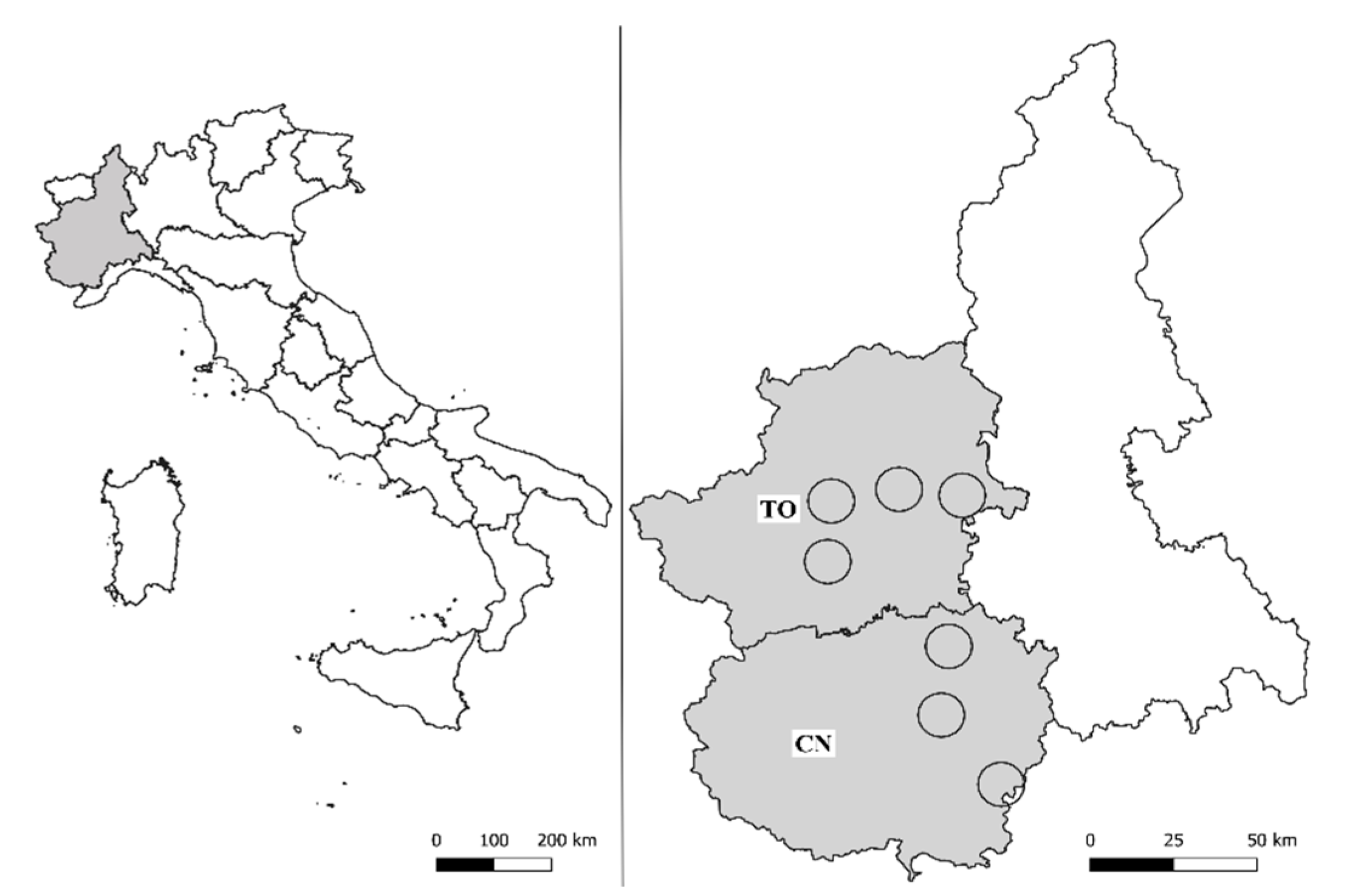

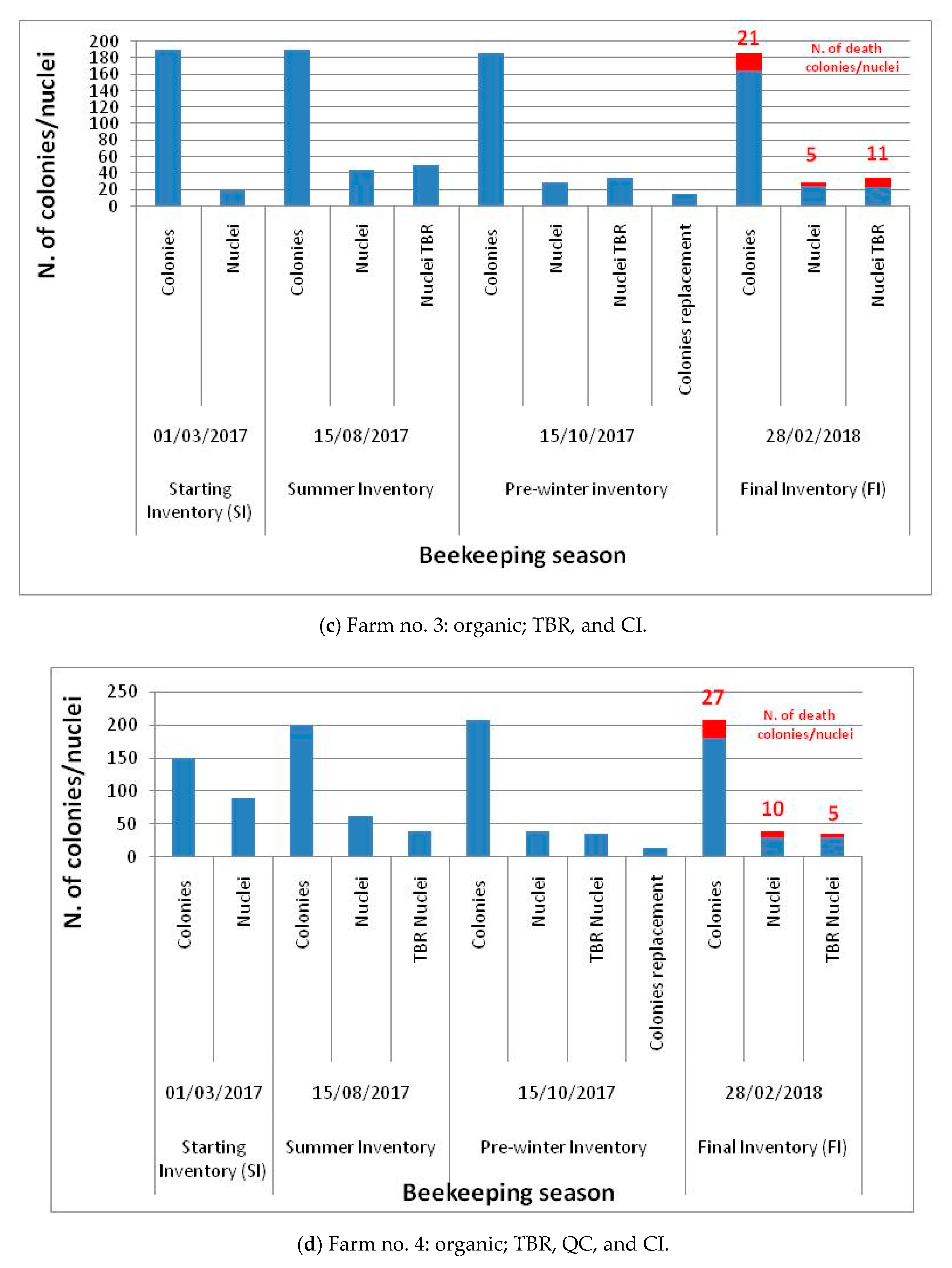
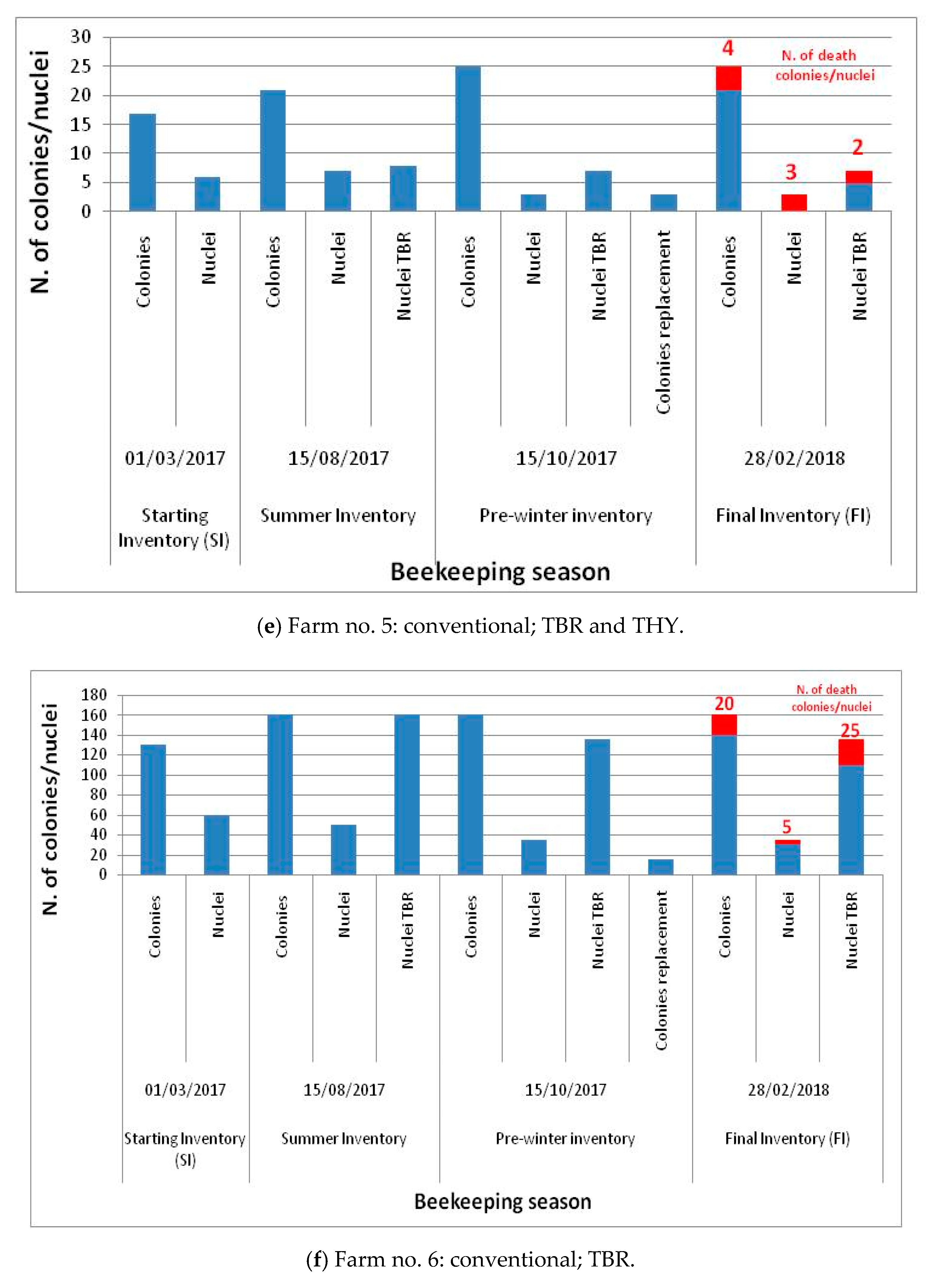
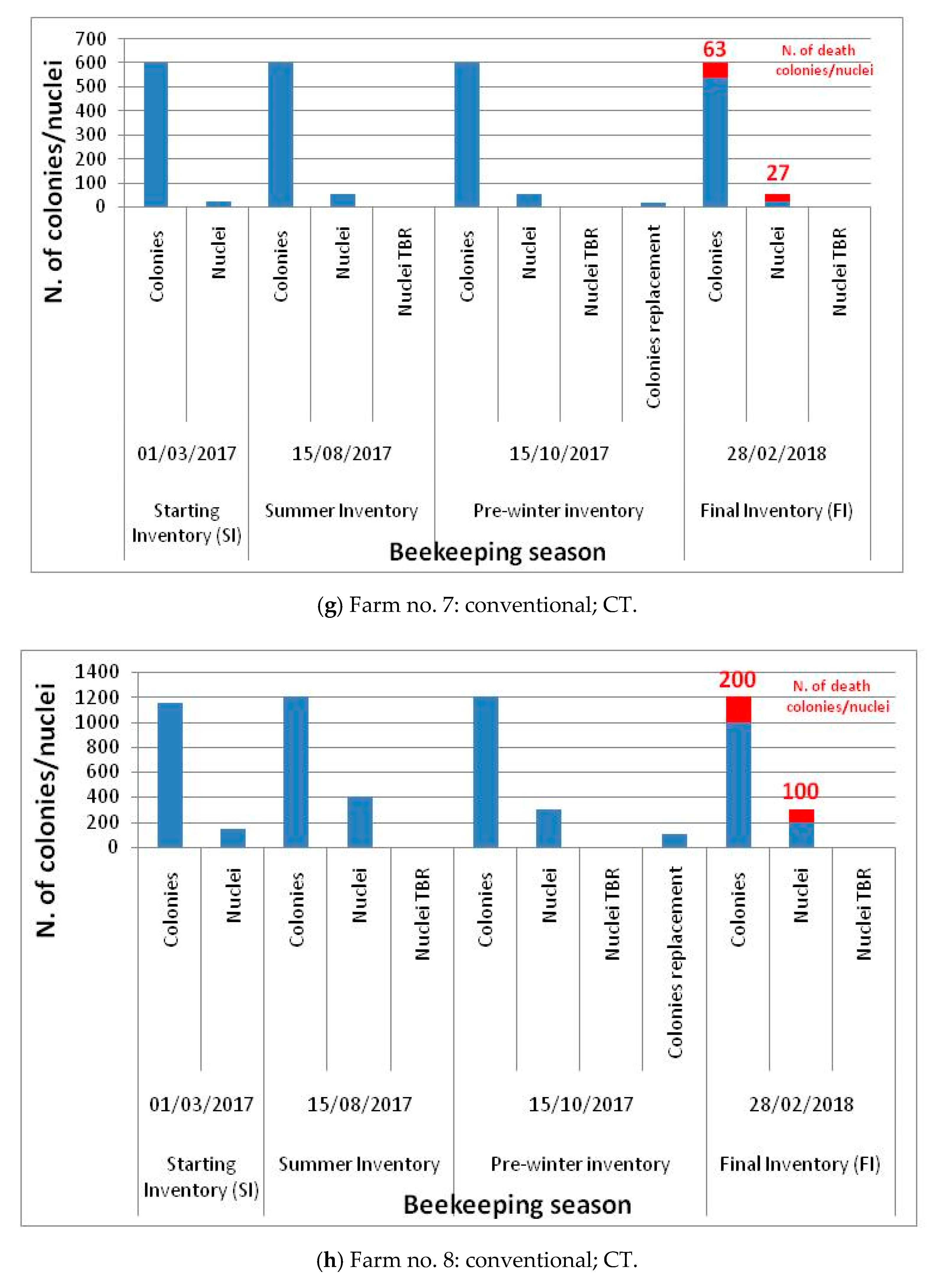
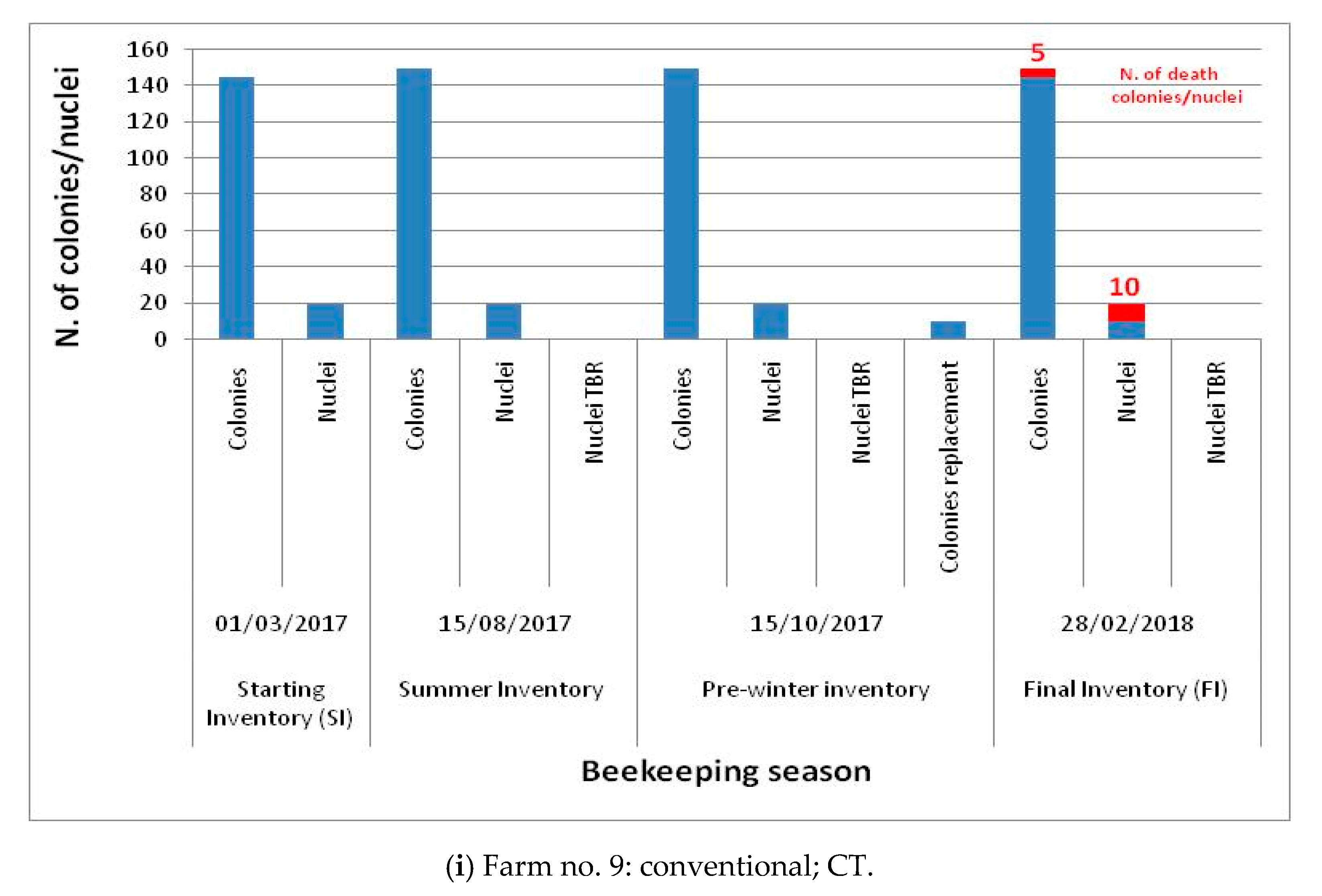
| Farms | Province * | Methods of Keeping Bees ** | Varroa Control Technique *** |
|---|---|---|---|
| 1 | CN | O | TBR, QC, CI |
| 2 | CN | O | TBR, QC, CI |
| 3 | TO | O | TBR, CI |
| 4 | TO | O | TBR, QC, CI |
| 5 | TO | C | TBR, THY |
| 6 | TO | C | TBR |
| 7 | CN | C | CT |
| 8 | CN | C | CT |
| 9 | TO | C | CT |
| FARMS (n.) | Size of Beekeeping Farms (n.) | HBCI (€) |
|---|---|---|
| 1 | 1070 | −15,860 |
| 2 | 1000 | −16,280 |
| 3 | 210 | −8185 |
| 4 | 240 | −140 |
| 5 | 23 | 320 |
| 6 | 190 | 8930 |
| 7 | 629 | −16,250 |
| 8 | 1300 | −34,000 |
| 9 | 165 | −3540 |
Publisher’s Note: MDPI stays neutral with regard to jurisdictional claims in published maps and institutional affiliations. |
© 2020 by the authors. Licensee MDPI, Basel, Switzerland. This article is an open access article distributed under the terms and conditions of the Creative Commons Attribution (CC BY) license (http://creativecommons.org/licenses/by/4.0/).
Share and Cite
Vercelli, M.; Croce, L.; Mancuso, T. An Economic Approach to Assess the Annual Stock in Beekeeping Farms: The Honey Bee Colony Inventory Tool. Sustainability 2020, 12, 9258. https://doi.org/10.3390/su12219258
Vercelli M, Croce L, Mancuso T. An Economic Approach to Assess the Annual Stock in Beekeeping Farms: The Honey Bee Colony Inventory Tool. Sustainability. 2020; 12(21):9258. https://doi.org/10.3390/su12219258
Chicago/Turabian StyleVercelli, Monica, Luca Croce, and Teresina Mancuso. 2020. "An Economic Approach to Assess the Annual Stock in Beekeeping Farms: The Honey Bee Colony Inventory Tool" Sustainability 12, no. 21: 9258. https://doi.org/10.3390/su12219258
APA StyleVercelli, M., Croce, L., & Mancuso, T. (2020). An Economic Approach to Assess the Annual Stock in Beekeeping Farms: The Honey Bee Colony Inventory Tool. Sustainability, 12(21), 9258. https://doi.org/10.3390/su12219258






